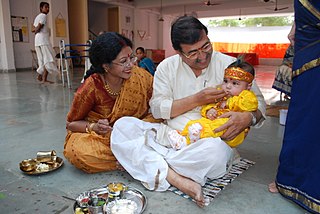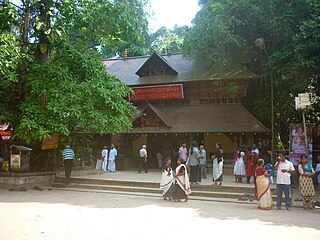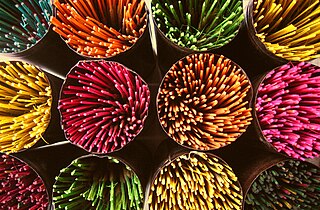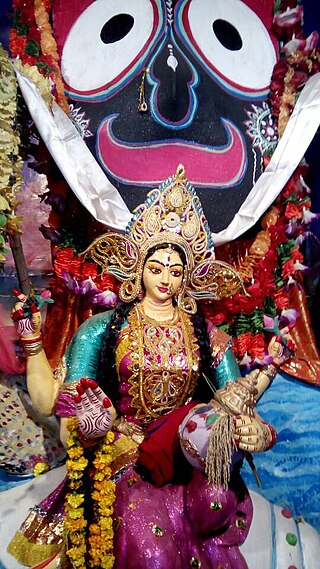Related Research Articles

Puja is a worship ritual performed by Hindus, Buddhists and Jains to offer devotional homage and prayer to one or more deities, to host and honor a guest, or to spiritually celebrate an event. It may honor or celebrate the presence of special guests, or their memories after they die. The word pūjā is Sanskrit, and means reverence, honor, homage, adoration, and worship. Puja, the loving offering of light, flowers, and water or food to the divine, is the essential ritual of Hinduism. For the worshipper, the divine is visible in the image, and the divinity sees the worshipper. The interaction between human and deity, between human and guru, is called darshan, seeing.

Arti or Arati is a Hindu ritual employed in worship, often part of a puja, in which light is ritually waved for the veneration of deities. Arti(s) also refers to the songs sung in praise of the deity, when the light is being offered. Sikhs also perform Aarti in the form of Aarti Kirtan which involves only devotional singing but Nihang Sikhs specifically perform Aarta which uses light as well.
Agnihotra refers to the yajna of offering ghee into the sacred fire as per strict rites, and may include twice-daily heated milk offering made by those in the Śrauta tradition. The ritual has been described by P.E. Dumont as a "fertility charm", and as a "solar charm" which symbolically preserved and created the sun at nightfall and sunrise.

Upanayana is a Hindu educational sacrament, one of the traditional saṃskāras or rites of passage that marked the acceptance of a student by a preceptor, such as a guru or acharya, and an individual's initiation into a school in Hinduism. Some traditions consider the ceremony as a spiritual rebirth for the child or future dvija, twice born. It signifies the acquisition of the knowledge of God and the start of a new and disciplined life as a brahmacharya. According to the given community and region, it is also known by numerous terms such as janai or janea, poita/paita, logun/nagun, yajnopavita, bratabandha, bratopanayan, and mekhal. The Upanayanam ceremony is arguably the most important rite for the Brahmin male, ensuring his rights and responsibilities as a Brahmin and signifying his advent into adulthood.

Yajna refers in Hinduism to any ritual done in front of a sacred fire, often with mantras. Yajna has been a Vedic tradition, described in a layer of Vedic literature called Brahmanas, as well as Yajurveda. The tradition has evolved from offering oblations and libations into sacred fire to symbolic offerings in the presence of sacred fire (Agni).

In Hinduism, the tilaka, colloquially known as a tika, is a mark worn usually on the forehead, at the point of the ajna chakra and sometimes other parts of the body such as the neck, hand, chest, or the arm. The tilaka may be worn daily for decorative purposes, as a symbol for sectarian affiliation, for rites of passage or for special spiritual and religious occasions, depending on regional customs. It is also used as an expression of honour or to welcome someone upon arrival.
A Hindu wedding, also known as Vivaha, Marathi: Lagna (लग्न), Bengali: Bibaho (বিবাহ) Kalyanam or Pelli, is the traditional wedding ceremony for Hindus. The wedding ceremonies are very colourful, and celebrations may extend for several days. The bride's and groom's home—entrance, doors, wall, floor, roof—are sometimes decorated with colors, flowers, and other decorations.

Kumkuma is a powder used for social and religious markings in India. It is made from turmeric or any other local materials. The turmeric is dried and powdered with a bit of slaked lime, which turns the rich yellow powder into a red color.

Śrauta is a Sanskrit word that means "belonging to śruti", that is, anything based on the Vedas of Hinduism. It is an adjective and prefix for texts, ceremonies or person associated with śruti. The term, for example, refers to Brahmins who specialise in the śruti corpus of texts, and Śrauta Brahmin traditions in modern times can be seen in Kerala and Coastal Andhra.
The following list consists of notable concepts that are derived from Hindu culture and associated cultures traditions, which are expressed as words in Sanskrit or other Indic languages and Dravidian languages. The main purpose of this list is to disambiguate multiple spellings, to make note of spellings no longer in use for these concepts, to define the concept in one or two lines, to make it easy for one to find and pin down specific concepts, and to provide a guide to unique concepts of Hinduism all in one place.

Samskara are sacraments in Hinduism and other Indian religions, described in ancient Sanskrit texts, as well as a concept in the karma theory of Indian philosophies. The word literally means "putting together, making perfect, getting ready, to prepare", or "a sacred or sanctifying ceremony" in ancient Sanskrit and Pali texts of India.

In Indic religions, a homa also known as havan, is a fire ritual performed on special occasions by a Hindu priest usually for a homeowner. The grihasth keeps different kinds of fire including one to cook food, heat a home, amongst other uses; therefore, a Yajna offering is made directly into the fire. A homa is sometimes called a "sacrifice ritual" because the fire destroys the offering, but a homa is more accurately a "votive ritual". The fire is the agent, and the offerings include those that are material and symbolic such as grains, ghee, milk, incense and seeds.

Pumsavana is the second of the 16 saṃskāras in ancient texts of Hinduism. The rite of passage is celebrated in the third or fourth month of pregnancy, typically after the pregnancy begins to show but before the baby begins to move in the womb.

Mannarasala Sree Nagaraja Temple in Haripad is a very ancient and internationally known centre of pilgrimage for the devotees of serpent gods (Nagaraja). The famous Nagaraja temple "Mannarasala" in Haripad is nestled in a forest glade, like most snake temples. The Mannarasala Temple has over 100,000 images of snakes along the paths and among the trees, and is the largest such temple in Kerala, India. Couples seeking fertility come to worship here, and upon the birth of their child come to hold thanksgiving ceremonies here, often bringing new snake images as offerings. A special turmeric paste which is available at the temple is credited with curative powers.

India is the world's main incense producing country, and is a major exporter to other countries. In India, incense sticks, called Agarbatti (Agar: from Dravidian probably Tamil அகில், அகிர் ., Sanskrit varti, meaning "stick" An older term "Dhūpavarti" is more commonly used in ancient and medieval texts which encompasses various types of stick incense recipes. Incense is part of the cottage industry in India and important part of many religions in the region since ancient times. The method of incense making with a bamboo stick as a core originated in India at the end of the 19th century, largely replacing the rolled, extruded or shaped method which is still used in India for dhoop.

The Urdhva Pundra is a tilaka worn by Vaishnavas as an indication of their affiliation with Vishnu. It is generally worn on the forehead, but may also be worn on other parts of the body such as the shoulders. The markings are made either as a daily ritual, or on special occasions, and denote the particular sampradaya, or the lineage to which the devotee belongs. The different Vaishnava sampradayas each have their own distinctive style of tilaka based on the siddhanta of their particular lineage. The general tilaka design is of two or three vertical lines resembling the letter U or Y, which represent the feet of Vishnu.

A Hindu priest may refer to either of the following:

Lakshmi Puja is a Hindu occasion for the veneration of Lakshmi, the goddess of prosperity and the supreme goddess of Vaishnavism. The occasion is celebrated on the amavasya in the Vikram Samvat Hindu calendar month of Ashwayuja or Kartika, on the third day of Deepavali in most part of India. In Assam, Bengal, and Odisha, this puja is celebrated 5 days after Vijaya Dashami.

Worship in Hinduism is an act of religious devotion usually directed to one or more Hindu deities. A sense of Bhakti or devotional love is generally invoked. This term is probably a central one in Hinduism, but a direct translation from the Sanskrit to English is difficult. Worship takes a multitude of forms depending on geography and language. Worship is not confined to any place of worship, and it will often incorporate personal reflection, music, dance and poetry. Hindus usually perform worship in temples or at home to achieve some specific end or to integrate the body, mind and spirit. The aim is to live a pure life in order to help the performer reincarnate into a higher being.
Astaprahari or Ashtaprahari is a Hindu ritual function performed in praise of the deity Krishna. Devotees participating in the function chant the name of the deity continuously for twenty-four hours in turn without break. The function is performed outside a house on specified days with particular instruments. It is mainly performed in the Indian states of Odisha and West Bengal.
References
- ↑ "Alta Dye: Bright Red Liquid Color Used to Adorn Palms and Feet". Utsavpedia. 2016-11-17. Retrieved 2020-10-16.
- ↑ "Learn How Bengali Mehndi Blends Simplicity, Authenticity and Ethnicity on the Wedding Day". www.weddingwire.in. Retrieved 2020-10-16.
- ↑ Oller, David. "Incense Making" . Retrieved 2013-08-02.